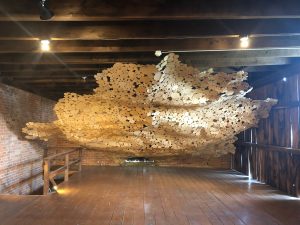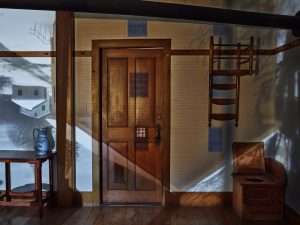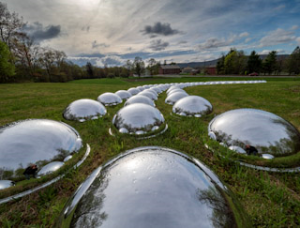Featuring work by Henry Klimowicz, Abelardo Morell, and Marko Remec, this exhibition explores how the repurposing of objects or landscapes can change the way we view them. Henry Klimowicz uses a seemingly utilitarian material – cardboard – to create organic sculptures that grow out of an inspired process, much like a bee creates a honeycomb. Abelardo Morell works with a camera obscura and shadows in the historic village to alter our perception of Shaker objects and a historic environment. Marko Remec creates a sculpture that changes how we think about a common object – a fiberglass mirror – by elevating its status to art and putting it in a field. Tracing the path of underground aqueducts that deliver water to the village from a reservoir in the hillside, the mirrors reflect the sky and landscape, altering our vision of Shaker innovation and music by giving us a new interpretive vocabulary. All three artists expand our views of a Shaker village with respect and imagination. Through November 12, 2018
ABELARDO MORELL
Inspired by the American artist Charles Sheeler and his fascination with the architecture and objects made by the Shakers, Abelardo Morell embarked upon a quest inside the 1830 Brick Dwelling to capture the nature of illumination – the fleeting light and shadow in the spaces that the Shakers once inhabited. Creating a camera obscura (sometimes referred to as a pinhole camera) in period rooms, Morell attached a lens on a window in a darkened space to bring exterior light and views to interior spaces, which resulted in images reflected upside down onto objects set against the opposite wall. Through this process, common artifacts and buildings become intriguing new compositions.
The artist also experimented with shadows and light, capturing their plentiful radiance as they flood the building and wrap around the furniture. Morell finds new ways to envision the forms, spaces, and lines of the Shaker environment, shaping the viewer’s perception with respect and imagination.
Image: View of the Sisters’ Shop Inside the Infirmary Room in the Brick Dwelling. Hancock Shaker Village, 2018
Courtesy of Edwynn Houk Gallery
About the Artist
Born in Havana, Cuba, Morell immigrated to the United States with his parents in 1962. His work has been collected and shown in many museums, including the Museum of Modern Art, the Whitney Museum of American Art, the Metropolitan Museum of Art, the Museum of Fine Arts, Boston, and the Victoria & Albert Museum. The author of many books, the artist’s most recent body of work, Flowers for Lisa, will be published by Abrams in October 2018.
MARKO REMEC
“I saw a vision … and I felt the power of God flow into my soul like a fountain of living water.” – Ann Lee, founder of the Shakers
In conjunction with the opening of the historic silos in 2018, New York-based conceptual sculptor Marko Remec created Monodic Flow – an outdoor installation of convex mirrors that cascades down the hillside at Hancock.
The path of mirrors echoes the flow of water in the underground aqueducts that the Shakers laid in 1818 from a reservoir at the top of the hillside to the village below. Water then powered their machinery, supplied the laundry, and afterward drained into distant fields to water the cattle and livestock. Nothing was wasted by the Shakers, and the aqueduct is still in use today.
A monody is a song sung by a single voice. Early Shaker music was sung in unison without instrumental accompaniment, the voices of the community coming together to offer a single prayer to God. To Remec, the Shakers’ presence in American history was like a lone melody against the bustle of society around them, spiritually and culturally.
Monodic Flow features over 160 dome mirrors, 32 inches each, stretching over 200 feet.
Made possible by the generosity of Stephanie and Tim Ingrassia
About the Artist
Marko Remec is a graduate of Williams College with degrees in Studio Art and Chemistry, Remec earned his MBA from Stanford University’s Graduate School of Business. A keen observer of the human condition, Remec translates firsthand experience to conceptual sculpture with a wry yet playful wit. Remec’s work has been shown at museums and sculpture parks including MASS MoCA, LongHouse Reserve, Chesterwood, Museo de Arte de Ponce, Salem Art Works, and the Hudson Valley Center for Contemporary Art.
HENRY KLIMOWICZ
Henry Klimowicz creates art out of cardboard, making remarkable sculptures from an ordinary material. The cardboard retains some text, helping the viewer reference its origins as a packing material while admiring its dramatic new identity. People sometimes place a value on art based on the material – a marble sculpture, a gold chest – or by their emotional or intellectual relationship to it. Klimowicz asks the audience to give cardboard value.
Inspired by the processes that shape the natural world, he is drawn to the organic forms that animals, winds, or waters create accidentally. The artist works without a specific goal in mind, uninterested in the overall form he is producing. “Think of me as a bee,” says Klimowicz, “working until I feel it is finished.”
Klimowicz feels a kinship with the Shakers, who repurposed materials to suit the needs of the community, and paid close attention to detail. He finds their devotion to the beauty found in a simple existence admirable, and tries to emulate it in his work.
About the Artist
Henry Klimowicz’s work has been exhibited at museums and art spaces such as the James A. Michener Art Museum (Doylestown, PA), the Wassaic Project (Wassaic, NY), Mizu (New York, NY), and the Morrison Gallery (Kent, CT). He created the Re Institute, a gallery based in a 1960s hayloft above his own barn studio in Millerton, NY. This experimental gallery space specializes in group shows of artists working in several mediums, which allows for the cross-pollination of ideas.



